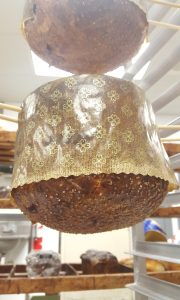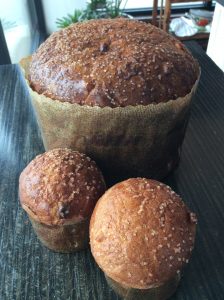
‘Tis the season to embrace holiday decadence, gluttony, and enough cookies to make your waist band bulge. While cookies tend to be the holiday front runner, our baking team has their mind on one thing this time of year…conquering the “everest of confections,” or better known to some as Panettone.
As the story goes, Panettone originated in Northern Italy, specifically Milan, almost 2 centuries ago. It quickly became Italy’s leading Christmas sweet by the end of World War II, ultimately garnering well known fame around the world. Now a holiday staple, the notorious boxed fruit-studded bread can be found on the shelves of most grocery stores. And while not knocking the commercially produced brands, if you ever have the chance to chance to try a fresh baked loaf of Panettone, do not pass it up.

It is a common misconception to relate Panettone to a fruit cake. When in actuality, it is anything but. Unlike its dense counterpart, Panettone is a light, leavened bread, almost pillow-like in texture. Made with the magic of extremely lively yeast, the rich dough is composed of wheat flour, eggs, butter, sugar, honey, and dried fruit.
We had the chance to be a fly on the wall during our bread bakers’ annual Panettone production and wanted to give you a behind the scenes sneak peak into all the love that goes into these holiday beauties. The process in and of itself is no small feat and takes about 2-3 days. Panettone is known to have a mind of its own and requires a knack for controlling the temperature, acidity, and fermentation process for the dough.
Ailene, one of our artisan bread bakers, walked us through her process step by step. She starts the dough with the initial fermentation phase which is responsible for Panettone’s spongy, delicate texture and “crumb.” She uses a natural yeast starter. On the second day , after the starter has rested overnight, she combines the starter with flour and water.

Patience is key in mixing Panettone as each additional ingredient has to be slowly incorporated. An abundance of egg yolks, sugar, honey, and butter are slowly introduced and mixed until the dough is thick and homogeneous. At this stage, Ailene stretches the dough in her hands to ensure the gluten strands have developed properly. Better known as the “the window pane test,” if you can see through the dough when stretched and it does not break, you have achieved the proper consistency.
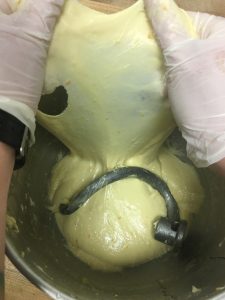
We like to mix in dried cranberries and candied orange peel at this point. After a 45 minute rest, Ailene performs 2 full stretching folds to give the bread more structure. After a second rest, she divvies and weighs the dough for a petit or full size paper mold. After a third and final rest, the dough is placed in the molds and is proofed in a warm environment for 2-4 hours.
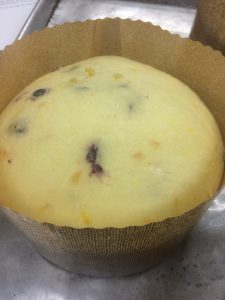
Once the dough has doubled in size, Ailene likes to score the top or sprinkle with pearlized sugar before baking off the loaves.
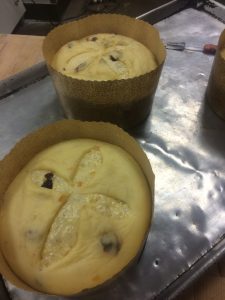
Now here comes the wacky part. After the bread is baked into a beautiful brown shaped dome, Ailene immediately punches 2 wooden skewers in the bottom of the molds and inverts them upside down to cool. This process ensures the soufflé-like dough doesn’t collapse and ruin all of those hard earned air pockets. There are endless applications if you do not finish eating the whole loaf at dinner…breakfast french toast, bread pudding, panzanella salad, sausage stuffing, etc. We hope you are lucky enough to get your hands on one, there is nothing quite like it!
